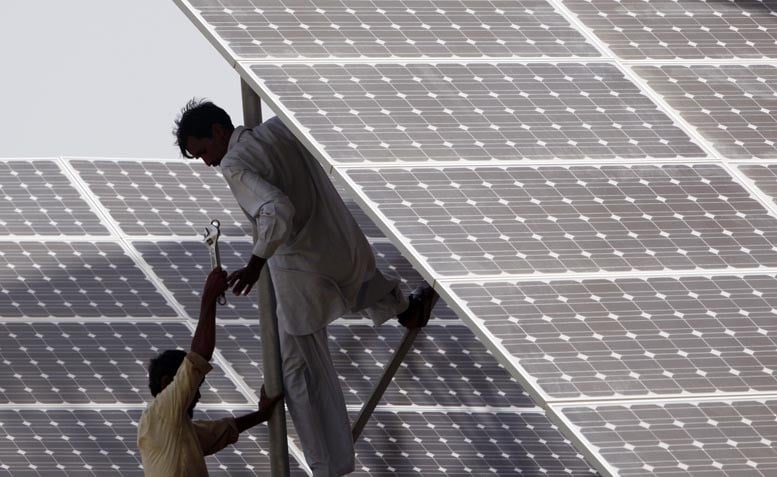
Pakistan’s new policy on renewable energy represents a step change in clean energy ambition

Pakistan’s Alternative Energy Development Board (AEDB) has published a draft of the long-awaited Alternative and Renewable Energy Policy. As has been discussed by the power minister on numerous occasions since the beginning of the year, the draft policy includes strong targets of reaching at least 20 percent renewable energy capacity by 2025 and at least 30 percent by 2030, up from around 4 percent currently.
Institute for Energy Economics and Financial Analysis (IEEFA) recognises that this ambition represents a significant step in renewable energy ambition for a nation currently focused on expanding hydro, coal- and LNG-fired power yet blessed with excellent wind and solar resources.
Recognising the sharply declining cost of renewable energy technology, the draft policy sets out a plan to expand wind and solar capacity via transparent, competitive bidding processes in order to enhance investor confidence and discover further cost reductions for least-cost electricity supply in Pakistan. However, Pakistan should be even more ambitious in embracing the technology-driven, global energy system disruption and the investment opportunities in renewable energy.
In December 2018, IEEFA published a report which found that the nation could approach 30 percent of power generation from renewables by 2030. According to our model, renewable energy would make up 36 percent of total power capacity by that date.
This higher level of renewables capacity could be reached by installing an average of 1 gigawatt (GW) each of wind and solar every year out to 2030, an installation rate below that achieved in other countries where incentivising policy settings are in place. In the 12 months to June 2019, Vietnam installed more than 4 GW of solar, incentivised by feed-in-tariffs, with an average construction time of just 275 days.
Given it is the China-Pakistan Economic Corridor (CPEC) programme that is driving Pakistan’s power capacity build out, the successful implementation of the new policy will depend, to a great extent, on China’s commitment to renewables in Pakistan. Domestically, China’s renewable energy investment is world leading. It increasingly dominates in new energy technology globally.
China has certainly made some positive statements. In January 2019, during a meeting between Power Minister Omar Ayub Khan and the Chinese ambassador to Pakistan, the ambassador stated, "Chinese investors are closely following Pakistan’s power-sector policies and are keen to invest in renewable energy." Despite these words, China is still pushing its coal technology on Pakistan.
The Pakistan government had understandably attempted to scale back the recently-commissioned Hub coal power plant, a 1,320MW CPEC project, and reduce it to 660MW on concerns about over-capacity and too much reliance on imported coal.
The Pakistan rupee has depreciated significantly over the last 18 months, making coal imports even more expensive and highlighting how inflationary coal imports will potentially be for the country. However, the project proceeded at full scale after the Chinese proponent of the joint venture raised the issue "at the highest level".
Meanwhile, the CPEC imported-coal-fired power projects already operational are suffering financial stress. The Port Qasim coal plant near Karachi is reportedly having financial difficulties partly caused by the expense of foreign currency denominated coal imports. The Sahiwal coal plant in the Punjab is also apparently having severe financial issues.
This plant is using imported coal, leading to major coal logistics issues.
In addition to the economic burden of importing fossil fuels, over-reliance on power plants fuelled by imported coal and LNG would be an energy-security concern for any nation.
Amongst the many benefits of wind and solar power technology is the fact that they do not require any fuel to be imported. This avoids the expense, logistics issues and the energy security issues that accompany reliance on seaborne fossil fuel imports.
In addition, renewables do not pose the water security threat that Pakistan’s planned fleet of domestic coal-fired plants do. Such plants will need to consume significant amounts of water every year for the project’s 40-year life and are often planned to be built in areas that are already water stressed. Coal plants to be fuelled by low-quality lignite from the Thar desert will be located in Sindh -- a province that has gone through a disruptive water crisis.
Pakistan also plans to build a chain of major dams with the aim of resolving water issues as well as provide more power. However, a recent report from the World Bank has called this plan into question, with the report’s author explaining that "new dams can help improve water security but will not address the most pressing water problems that Pakistan faces".
Plans for hydro power are also held back by the difficulty in financing some projects and the very long construction time required -- an issue not faced by wind and solar power.
China is under pressure to "green" its Belt and Road Initiative (BRI), of which the CPEC is a leading element. So far, Chinese power investment in Pakistan has been fairly typical of its investment in other BRI countries in that it is focused to a great extent on coal-fired power.
With Pakistan’s government now keen to benefit from the advantages of ever-cheaper renewable energy, the country is now becoming a key case study on China’s "greening the BRI" progress.
China has made some positive statements regarding renewables investment in Pakistan. Now it needs to back those words up with an ambitious action on the ground.
The writer is an energy finance analyst at the IEEFA